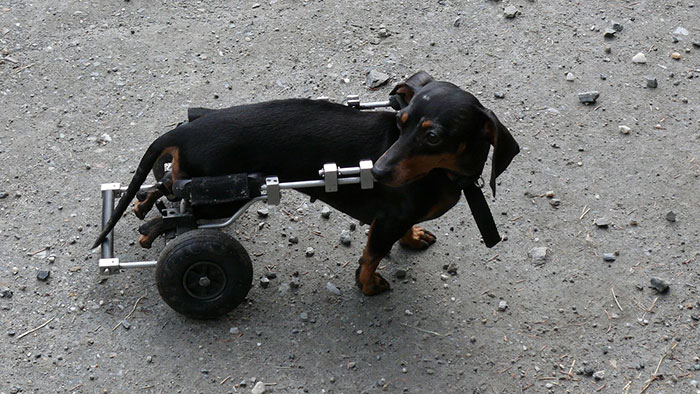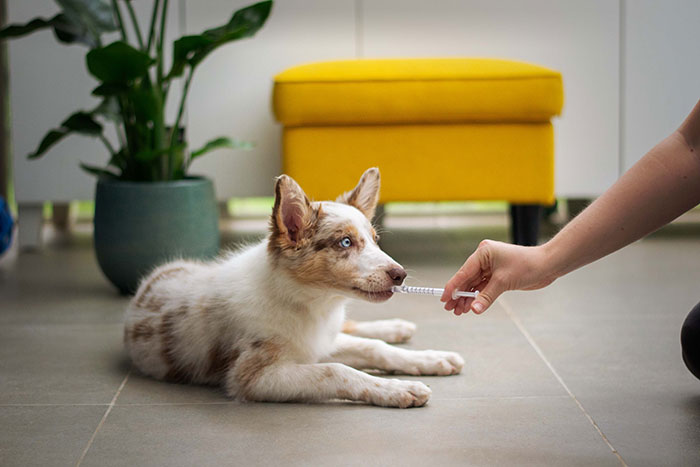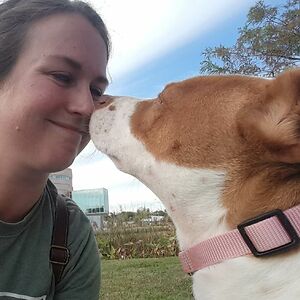Caring for a paralyzed dog comes with its challenges – take it from me. I spent years caring for a dog who was unable to move his hind legs or tail due to damage to the spinal cord he sustained when he was just a puppy.
A paralyzed dog can live a relatively normal life with the care and support of a loving person. Here’s what you need to know about how to care for your paralyzed dog.
- Paralyzed dogs can lead nearly normal lives with proper care.
- IVDD, a common cause for paralysis, can be more prevalent in certain breeds.
- Physical therapy and wheelchairs can improve a paralyzed dog's mobility.
- Keeping a paralyzed dog clean helps prevent skin rashes and infections.
- Paralyzed dogs can still enjoy playtime and mental stimulation.
The information provided herein is for informational purposes only. Please refer to our disclaimer for more details..
What Is Paralysis in Dogs?
A paralyzed dog can’t move one or more parts of its body. When partially paralyzed, a dog retains some movement control but lacks coordination and fine motor skills. Dogs who are fully paralyzed are completely unable to move certain body parts.
Symptoms include dragging hind legs, lack of coordination, and inability to stand or walk. Dogs showing signs of paralysis often become incontinent. Some are unable to void their bladder or bowels without assistance.
Prompt veterinary care is crucial if you suspect canine paralysis. A veterinarian may be able to help your dog before they lose motor function permanently. Understanding what’s going on is the first step to help your paralyzed dog.
Common Causes of Paralysis in Dogs
Image credits: Markus Winkler.
Intervertebral Disc Disease (IVDD):
IVDD is when the discs between the vertebrae in the spinal column degenerate and/or herniate, leading to spinal cord compression, pain, nerve damage, and often, paralysis.
Some dog breeds are more prone to IVDD than others, so they require special care to avoid it. Long-backed breeds like Dachshunds are very prone to it, as are some other breeds like Miniature Poodles and German Shepherds.
Spinal Injuries:
Trauma from falls, accidents, or sudden impacts can cause inflammation in the spinal cord that affects movement. If the pressure isn’t relieved, paralysis may result.
Sometimes, an apparently minor injury like a short fall or a small stumble can actually be the reason a dog may become paralyzed. This why it’s essential to wrack your brain for underlying causes for your dog’s symptoms.
Tumors:
Tumors near the spinal cord can disrupt communication between the spinal cord and the rest of the body, putting pressure on the spinal cord and causing symptoms of paralysis in dogs.
In some cases, surgery or other cancer treatment can relieve the dog’s paralysis.
Inflammatory Diseases:
Disease of the spinal cord, like meningitis or myelitis, can cause inflammation in the nervous system. This is one of the most common causes of paralysis that may have a good outcome with treatments like anti-inflammatory medications.
Congenital Disorders:
Some dogs are born with congenital disorders affecting the spinal cord or other parts of the nervous system. As they develop, these disorders can lead to paralysis.
Many dogs in this situation benefit from surgery, while others go on to live quality lives despite their disability.
Caring for a Paralyzed Dog
Image credits: cello5.
Caring for a dog without the ability to walk or even go potty without help isn’t easy. It’s hard enough when paralysis is temporary, but when you know paralysis may be permanent, it can really be overwhelming.
There are unique joys in loving and caring for a disabled dog. It was one of the most influential and inspiring experiences of my life.
Seeing my dog overcome challenges and live his best life despite his disability gives me the courage every day to face my own obstacles with the same give-it-your-all energy he applied to every day of his life.
Here’s what I learned about how to give a dog an active life despite paralysis.
Skin Care and Cleanliness:
Urine and feces are incredibly caustic. They can result in painful rashes faster than seems possible. Paralyzed limbs don’t feel pain, so dogs may drag their limbs over abrasive surfaces, leave them in urine or feces, or even chew on them.
Once a wound or rash starts, getting it under control isn’t easy. Maintaining cleanliness and protection is a top priority, especially in areas that drag along the ground.
Frequent Epsom and oatmeal baths are a great way to prevent small irritations from getting worse. Diapers, clothes, dog booties, and medical wraps are all useful for protecting the skin from rubbing or chewing. Human pants, cut to size and with a tail hole removed, are an adorable and practical way to protect the lower body.
Mobility:
Your dog needs to get out and enjoy life but you can’t carry your dog everywhere. Even if a dog is unable to walk, they still want to explore on their own. Furthermore, getting up and about prevents pressure sores and maintains muscle tone.
Dog wheelchairs are a simple and effective way to give a dog the freedom of movement. My pup’s Walking Wheels wheelchair allowed him to go on walks, run on the beach, and do pretty much anything any other dog could do.
A body support sling or harness can also offer support, especially during quick walks or bathroom breaks.
Physical Therapy:
Physical therapy can significantly aid in maintaining muscle tone, improving circulation, and enhancing overall comfort. It can even get a dog back on their feet, depending on the cause of the paralysis and whether it is curable.
Working with a rehab therapy professional specializing in canine rehabilitation is a superb way to get a personalized therapy plan for your dog.
Even if you can’t afford or don’t live near a canine physical therapist, you can still offer a lot of therapy at home with the help of your family veterinarian.
Massage, motion exercises, swimming, and strength training can all be done at home. Just be sure to learn from a professional before you start therapy yourself so you’ll be sure to make a positive impact for your dog.
Urination and Defecation:
Paralysis often affects a dog’s ability to control bladder and bowel movements. They may need to have their bladder expressed and bowel movements stimulated regularly.
Some paralyzed dogs continuously leak urine and can’t control defecation. Diapers for dogs are a practical way to keep your dog clean and dry, but it’s essential to change them as soon as they’re full to prevent diaper rash.
Food and Water:
Dogs that have trouble expressing their own bladder or who leak urine are prone to urinary tract infections, so hydration is essential. Furthermore, less concentrated urine is less likely to give your dog a rash. Your dog’s urine should be nearly clear and odorless.
Make sure fresh water is always available. Add some flavor, like unsalted chicken broth, to tempt dogs who don’t drink enough.
For a dog that can’t move about easily to entertain themselves, food is an important source of mental stimulation, as well as nourishment. On the other hand, it’s essential to maintain an ideal weight, as any extra pounds make it that much harder for your dog to maintain a good level of mobility.
Food puzzle toys were indispensable in keeping my dog mentally stimulated and avoiding overfeeding. Toys that roll away from your dog also encourage them to move and change position. Experiment with puzzle toys to see what works for your dog, and be sure to allot only the veterinary-recommended amount of food each day.
Exercise and Play:
Despite their physical limitations, paralyzed dogs still love life and long to play. Be constantly on the lookout to adapt toys and games to accommodate your dog’s level of mobility.
Many paralyzed dogs do great in the water, and swimming is superb therapy, so try playing fetch in the pool instead of in the yard. A gentle game of tug is a great way to get your dog active and moving, even if they’re lying down.
Many paralyzed dogs do great playing with other dogs, so see if a doggy playdate is a good option for them.
Adopting a Paralyzed Dog
Image credits: Ayla Verschueren.
Adopting my pup after he experienced sudden paralysis was one of the biggest decisions of my life. Choosing to take on a paralyzed dog can bring incredible rewards, but it can be overwhelming. Make sure you know what you’re taking on:
- Do your research: Educate yourself on the care and common conditions associated with paralysis in dogs. I wrote a book about caring for a paralyzed dog that you may find helpful. Ideally, you’ll have the opportunity to understand the cause of paralysis, available treatment options, and daily care needs for the specific dog you’re considering adopting.
- Find a good local vet: Your family vet will be your go-to source for medical advice, treatment plans, and regular check-ups to manage your dog’s paralysis. Trust me, you’ll need a good one. It’s great to consult with a vet who has experience with paralyzed dogs or neurological conditions, but any good vet can handle day-to-day needs.
- Prepare your home: Accommodating a paralyzed dog requires some adjustments. Do NOT assume that the diaper will be foolproof. Provide a space in every room of the house where cleanup won’t be a hassle.
- Get the equipment: If your dog isn’t coming with a wheelchair or harness, have them fitted as soon as possible. Be sure to have a couple of types of diapers, bandaging material, clothes, and everything else your dog might need.
Living With A Paralyzed Dog? Get Support
The veterinary community I worked in offered me invaluable support, but even if you don’t have a work environment like this, you can find great resources. I also found tremendous help from support groups and online communities for owners of paralyzed or disabled dogs.
The advice, encouragement, and resources they offer got me through many a sticky spot. Just sharing experiences with people who have faced similar challenges can be incredibly comforting.
FAQ
What to do if your dog is paralyzed?
If your dog is paralyzed consult a veterinarian immediately. A diagnosis and treatment plan may be able to reduce or completely relieve your pet’s paralysis. Avoid moving your dog, as it could exacerbate the injury. Call your vet first so they can let you know how you may be able to move your dog safely.
Can a dog recover from paralysis?
A paralyzed dog may recover. It depends on the underlying cause and the extent of the injury. Some conditions affecting older dogs, like degenerative myelopathy, have no cure. On the other hand, rest and medications or surgery may relieve symptoms in a paralyzed pet suffering from IVDD. In some cases, especially with early and appropriate treatment, dogs may regain some or all of their mobility. However, treatment may not help other dogs.
How long can a paralyzed dog live?
The lifespan of a paralyzed dog can be normal with proper care, management, and regular check-ups. However, the increased risk of infections, arthritis, and other conditions may shorten a dog’s lifespan.
Can a paralyzed dog have a good life?
Absolutely. With the right care, treatment, and mobility aids, paralyzed dogs can lead happy, full lives. My paralyzed dog lived a richer, fuller life than many healthy dogs I’ve known. Provide a supportive, loving environment, regular exercise and fun, and proper medical care, and your dog will likely seem unbothered by their limitations.
Thanks for this post. My beautiful beagle, Jeremy, lost the use of his back legs overnight. I took him to the veterinary clinic and they said to put him down. One year later he is still going strong! I got him little wheels and he is recovering slowly but getting better everyday. I want to pass on my brothers advise - ‘he isn’t in any pain, and he is disabled but not dying’ - these words saved Jeremy’s life and I am so happy every day to watch him enjoying his doggy life! It is a little harder to care for a disabled dog - but it is worth it!
Thanks for this post. My beautiful beagle, Jeremy, lost the use of his back legs overnight. I took him to the veterinary clinic and they said to put him down. One year later he is still going strong! I got him little wheels and he is recovering slowly but getting better everyday. I want to pass on my brothers advise - ‘he isn’t in any pain, and he is disabled but not dying’ - these words saved Jeremy’s life and I am so happy every day to watch him enjoying his doggy life! It is a little harder to care for a disabled dog - but it is worth it!







6
2